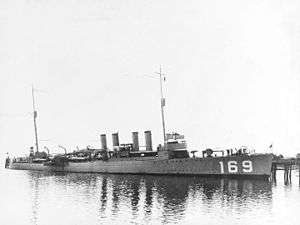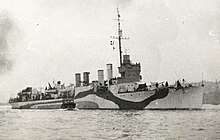USS Foote (DD-169)
The second USS Foote (DD–169) was a Wickes-class destroyer in the United States Navy following World War I. She was transferred to the Royal Navy as HMS Roxborough (I07) and later to the Soviet Navy as Zhyostky (or Doblestny ; sources vary).
 | |
| History | |
|---|---|
| Name: | Foote |
| Namesake: | Andrew Hull Foote |
| Builder: | Fore River Shipbuilding Company, Quincy, Massachusetts |
| Laid down: | 7 August 1918 |
| Launched: | 14 December 1918 |
| Commissioned: | 21 March 1919 |
| Decommissioned: | 6 July 1922 |
| Recommissioned: | 2 July 1940 |
| Decommissioned: | 23 September 1940 |
| Stricken: | 8 January 1941 |
| Fate: | Transferred to United Kingdom, 23 September 1940 |
| Name: | HMS Roxborough |
| Commissioned: | 23 September 1940 |
| Identification: | I07 |
| Fate: | Transferred to USSR, 1 August 1944 |
| Name: |
|
| Acquired: | 1 August 1944 |
| Fate: | Returned to UK, 7 February 1949 for scrapping, 14 May 1949 |
| General characteristics | |
| Class and type: | Wickes-class destroyer |
| Displacement: | 1,060 tons |
| Length: | 314 ft 5 in (95.83 m) |
| Beam: | 31 ft 8 in (9.65 m) |
| Draft: | 9 ft 2 in (2.79 m) |
| Speed: | 35 knots (65 km/h; 40 mph) |
| Complement: | 101 officers and enlisted |
| Armament: |
|
Service history
As USS Foote
Named for Admiral Andrew Hull Foote, she was launched 14 December 1918 by Fore River Shipbuilding Company, Quincy, Massachusetts; sponsored by Mrs. Lelia F. Cady, daughter of Admiral Foote; and commissioned 21 March 1919, Lieutenant Commander D. H. Stuart in command.
Foote sailed from Boston 3 May 1919 to take up an observation station off Newfoundland for the historic first aerial crossing of the Atlantic, made later that month by Navy seaplanes. She returned to Boston 22 May to complete her interrupted fitting out, then took part in training operations until sailing from Newport 27 August bound for a tour of duty with Naval Forces European Waters. From September through December, she served in the Adriatic, and then called at Italian and French ports homeward bound. Arriving at Boston 12 February 1920, she was placed in reserve 24 February for repairs there and at Charleston.
In the summer of 1921, Foote operated with 50 percent of her complement during summer target practice in Narragansett Bay, and returning to Charleston, she lay there and at Boston for alterations and repairs until decommissioned at Philadelphia 6 July 1922. Recommissioned 2 July 1940, Foote operated on patrol out of Charleston, until sailing 7 September for Halifax, Nova Scotia. There, on 23 September 1940, she was decommissioned and transferred to the Royal Navy in the destroyers for land bases exchange.
As HMS Roxborough
_underway_in_Hampton_Roads_on_3_September_1942.jpg)
Commissioned as HMS Roxborough 23 September 1940, the destroyer crossed the Atlantic to join the Western Approaches Command, guarding convoys during the dangerous last leg of their voyages into British ports. In March 1942, Roxborough took up western Atlantic escort duty out of Halifax, Nova Scotia. Roxborough was modified for trade convoy escort service by removal of three of the original 4 in (102 mm)/50 guns and one of the triple torpedo tube mounts to reduce topside weight for additional depth charge stowage and installation of Hedgehog anti-submarine mortar.[1]
While with convoy HX222 Roxborough met with such heavy weather that the entire bridge structure was crushed, with eleven dead, including the Commanding Officer and 1st Lieutenant. The sole surviving executive officer managed to regain control of the ship, and under hand steering from aft, she made St. Johns, Newfoundland.
Returning to the Tyne 10 January 1944, Roxborough lay in reserve there until transferred to the Soviet Navy on 1 August 1944.
In Soviet service

On 1 August 1944 Roxborough was transferred to the Soviet Navy. She was renamed (sources vary) either Zhyostky (rus. "Rigid")[2] or Doblestny (rus. "Glorious or Valiant").[3] She was returned to Great Britain 7 February 1949 and was scrapped on 14 May 1949.
Notes
- Lenton&Colledge (1968) p.92
- DANFS
- Conway p332
References
- Gardiner R, Chesnau R (1980) Conway's All the World's Fighting Ships: 1922-1946 ISBN 0-85177-146-7
- Destroyers for Great Britain: A History of 50 Town Class Ships Transferred From the United States to Great Britain in 1940 (Rev. and expanded ed.). Annapolis, Maryland: Naval Institute Press. 1988. ISBN 0-87021-782-8.
- Lenton, H.T. and Colledge J.J. (1968). British and Dominion Warships of World War II. Doubleday and Company.
- This article incorporates text from the public domain Dictionary of American Naval Fighting Ships. The entry can be found here.
External links
| Wikimedia Commons has media related to USS Foote (DD-169). |